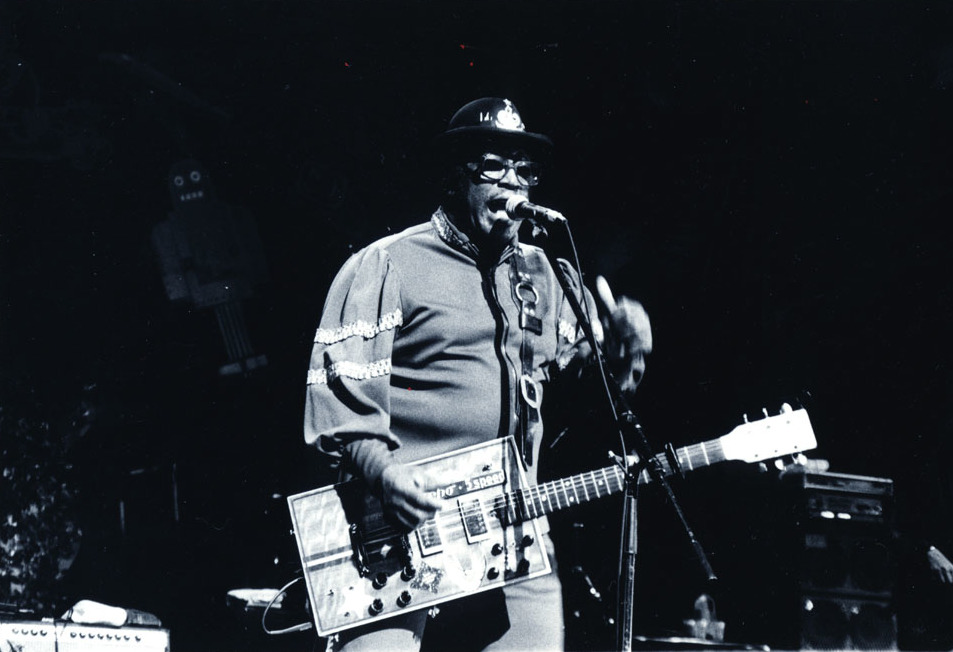Precursors
The migration of African Americans to the urban industrial centers of Chicago, Detroit, New York, Los Angeles and elsewhere in the 1920s and 1930s created a new market for jazz, blues, and related genres of music, often performed by full-time musicians, either working alone or in small groups. The precursors of rhythm and blues came from jazz and blues, which overlapped in the Late-1920s,1930s through the work of musicians such as The Harlem Hamfats, with their 1936 hit "Oh Red", as well as Lonnie Johnson, Leroy Carr, Cab Calloway, Count Basie, and T-Bone Walker. There was also increasing emphasis on the electric guitar as a lead instrument, as well as the piano and saxophone.

African American music began incorporating Afro-Cuban rhythmic motifs in the 1800s with the popularity of the Cuban contradanza (known outside of Cuba as the habanera).[24] The habanera rhythm can be thought of as a combination oftresillo and the backbeat.

"Misery" by Professor Longhair (1957).

Piano excerpt from the rumba boogie "Mardi Gras in New Orleans" (1949) by Professor Longhair. 2–3 clave is written above for rhythmic reference.

Saxophone guajeo in blues progression. "Mambo Boogie" by Johnny Otis (1951).
Early to mid-1950s
Johnny Otis, who had signed with the Newark, New Jersey-based Savoy Records, produced many R&B hits in 1951, including: "Double Crossing Blues", "Mistrustin' Blues" and "Cupid's Boogie", all of which hit number one that year.
In 1951, Little Richard Penniman began recording for RCA Records in the jump blues style of late 1940s stars Roy Brown and Billy Wright.
Ruth Brown on the Atlantic label, placed hits in the top 5 every year from 1951 through 1954: "Teardrops from My Eyes", "Five, Ten, Fifteen Hours", "(Mama) He Treats Your Daughter Mean" and "What a Dream".
Late 1950s
In 1956, an R&B "Top Stars of '56" tour took place, with headliners Al Hibbler, Frankie Lymon and the Teenagers, and Carl Perkins, whose "Blue Suede Shoes" was very popular with R&B music buyers.
Two Elvis Presley records made the R&B top five in 1957: "Jailhouse Rock"/"Treat Me Nice" at #1, and "All Shook Up" at #5, an unprecedented acceptance of a non-African American artist into a music category known for being created by blacks.In 1959, two black-owned record labels, one of which would become hugely successful, made their debut: Sam Cooke's Sar, and Berry Gordy's Motown Records.[75] Brook Benton was at the top of the R&B charts in 1959 and 1960 with one #1 and two #2 hits. Benton had a certain warmth in his voice that attracted a wide variety of listeners, and his ballads led to comparisons with performers such as Cole, Sinatra and Tony Bennett.[76] Lloyd Price, who in 1952 had a #1 hit with "Lawdy Miss Clawdy" regained predominance with a version of "Stagger Lee" at #1 and "Personality" at #5 for in 1959.[77][78]
The white bandleader of the Bill Black Combo, Bill Black, who had helped start Elvis Presley's career, was popular with black listeners. Ninety percent of his record sales were from black people, and his "Smokey, Part 2" (1959) rose to the #1 position on black music charts. He was once told that "a lot of those stations still think you're a black group because the sound feels funky and black." Hi Records did not feature pictures of the Combo on early records.

1960s and late
Sam Cooke's #5 hit "Chain Gang" is indicative of R&B in 1960, as is Chubby Checker's #5 hit "The Twist".[80][81] By the early 1960s, the music industry category previously known as rhythm and blues was being called soul music, and similar music by white artists was labeled blue eyed soul.
By the 1970s[citation needed], the term rhythm and blues was being used as a blanket term for soul, funk, and disco. Around the same time, earlier R&B was an influence on British pub rock and later, the mod revival. Now the term R&B is almost always used instead of the full rhythm and blues, and mainstream use of the term usually refers to contemporary R&B, which is a newer version of soul and funk-influenced pop music that originated as disco faded from popularity.
No comments:
Post a Comment